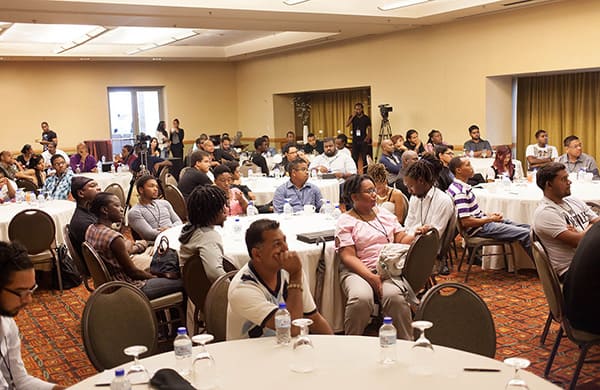
Above: The audience at the conference on Caribbean Dance Music at the Hyatt Regency Hotel. Photo by Mark Lyndersay.
BitDepth#1002 for August 18, 2015
On August 7, in the shadow of the International Conference on Pan, a group of young musicians and producers gathered in a room at the Hyatt Regency Hotel to discuss the future of something called “Caribbean Dance Music.”
CDM is apparently a new framework meant to contain the many flavours of beats that are created in the region to get people onto a dance floor.
It isn’t clear that there is a proven need for yet another descriptive for the many regional rhythms that have, either collectively or individually, created little more than an occasional blip in the large music consumption markets of the first world.
But this discussion, nominally on copyright, leapfrogged such concerns to helpfully focus on the reason for the reason for licensing, making money.
It was clear that the team promoting CDM were about pressing home practical discussions and advice about raising the game for the young producers, composers and performers who have tended to find themselves on the fringes of a burgeoning and extremely fluid market for music.
Professor Kienda Hoji, Principal Lecturer in Music Business & Entertainment Law at the University of Westminster was upfront about his approach.
“I get my hands dirty,” he told the SRO room via Skype from the UK, “I believe that if you are going to teach this you have to do it.”
Describing copyright as one of the “dark arts” of the music industry, Hoji said, “People generally don’t understand how it works, bt it’s generally a good idea to come to an understanding of the process, because it’s the way that you get paid.”
He did admit that the only time he found himself professionally stymied on the subject was in China, where copyright is nonexistent, and even the idea of being paid for a cultural contribution was frowned on.
The law lecturer acknowledged that the idea of copyright tends to fly in the face of modern digital technologies that emphasise effortless sharing, but the larger issue is working the market itself, which is seeing a fundamental shift in the way that people consume entertainment in general and music in particular.
“People are not so much interested in owning music or seeing a disc spin and having that physical experience,” Hoji said, “people are more interested in access.”
In addition, there are challenges of perception, which finds consumers assuming everyone in the music industry is rich so there’s no need to pay people for their work.
“It’s just a small tip of the iceberg of creators who make a sustainable living from the industry,” Hoji said.
So how do the young creators and producers make money in an environment that’s seems at best hostile and for many, downright toxic?
That was Dana Shayegan’s mission at the event.
As the V.P. Collective Digital Studios he’s worked extensively in the region, representing several artists in Jamaica along with Timaya, Walshy Fire and Machel Montano in the digital realm.
Earlier in the conference he presented a remarkably detailed and action focused talk on optimization, marketing and monetising YouTube posts.
CDS represents YouTube ‘properties’ for these entertainment brands which focus on Electronic Dance Music (EDM), Caribbean and Afrobeats music and claims a collective 15 million subscribers to their channels, 300 million monthly views and 1 million live event attendees on behalf of the artistes that work with them.
Clearly there is room to grow with his organisation, but Shayegan was also clear that there’s a lot more that creators can do on their own using the same platform and offered generous advice in getting started.
First, he recommended that creators clarify ownership of their works in writing, including the percentages that others hold in neighboring rights, so that they can properly apply for a YouTube Content ID, the first step in getting paid for views on the website.
That can be a real problem in the region; Professor Hoji noted.
“There’s a real difficulty in getting that done,” he said, “there’s a lot of ‘Whahappen, you don’t trust me,’ but if you want to go there, you have to get that done.”
Both presenters suggested getting a reputable and experienced entertainment lawyer to sort out exactly who owns what and how much of it every rights holder is entitled to earn.
Then, the process follows what’s emerged as social media best practice, posting interesting work regularly and for YouTube, binding the posts into a channel that runs continuously, building ‘watch time.’
Shayegan encouraged creators to build multiple instances of strong tracks, reaching beyond the grail of the music video to create art tracks, lyric videos and behind the scenes posts to engage viewers and hold them in a fully optimized YouTube channel.
If this is all starting to sound like programme management, it’s because it is, and it’s all in support of building an effective brand, the creator’s sharpest sword in cutting through to an audience.
In summary, Dana Shayegan offered the following advice to creators: “If you have any interest in making music and making money, you need to understand this topic, protect your copyright, but also be prepared to be lenient when promotional opportunities arise.”
Dana Shayegan agreed to share a PDF of his presentation at the CDM conference. Download it here: Dana Shayegan CDMC Keynote Presentation



